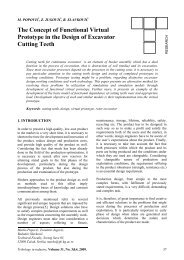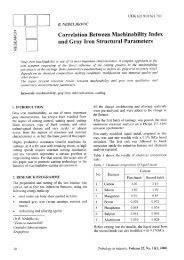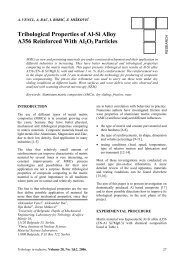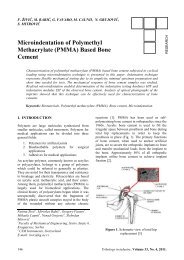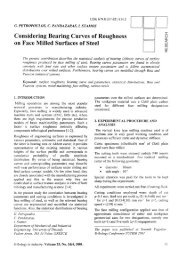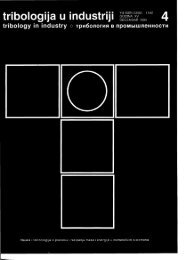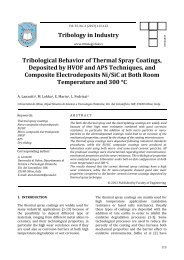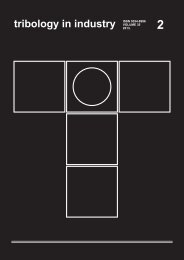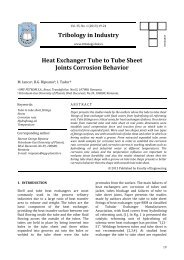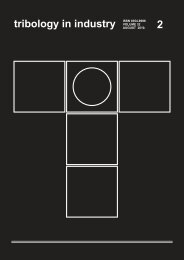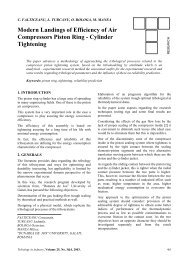No. 4, 1998 - Tribology in Industry
No. 4, 1998 - Tribology in Industry
No. 4, 1998 - Tribology in Industry
Create successful ePaper yourself
Turn your PDF publications into a flip-book with our unique Google optimized e-Paper software.
area of triboiogy of the real mach<strong>in</strong>e svstems, and that<br />
<strong>in</strong>fluences of numerous <strong>in</strong>dividuel factors on prJcesses<br />
of friction and wear are <strong>in</strong>sufficiently knorvn, let us remark<br />
that tlie similar situation exists when one considers<br />
friction and friction mechanisms of mach<strong>in</strong>e elements.<br />
This is especially expressed <strong>in</strong> modern mechanical power<br />
transmitten by friction (frictional, belt and cha<strong>in</strong>), where<br />
the process of oppos<strong>in</strong>g the reiative motion is used for<br />
ihe basic function and purpose of transmitters. The mechanism<br />
of power transmission by the idle friction is still<br />
<strong>in</strong>sufficiently understood, and especially are <strong>in</strong>sufficiently<br />
known previous displacements, relative micro-displarcments,<br />
at which theses processes occur.<br />
4. MACHINE ELEMENTS WEAR<br />
Wear is, <strong>in</strong> general sense, any type of material removal<br />
from the contact surfaces. Simultaneously, that is also the<br />
natural process, that can not be avoided, and which<br />
accompanies operation of eech mach<strong>in</strong>e element and<br />
mach<strong>in</strong>e system as a whole. Consequences of wear are<br />
changes of system's technical parameters, changes <strong>in</strong><br />
function<strong>in</strong>g, and f<strong>in</strong>ally, removal from exploitation, or <strong>in</strong><br />
the extreme case fracture and failure.<br />
Period of functional ag<strong>in</strong>g of mach<strong>in</strong>e systems is, <strong>in</strong><br />
pr<strong>in</strong>ciple, significantly longer than the period of permissible<br />
wear of mach<strong>in</strong>e elements. Physical wear of elements<br />
(/.5 to 2 years) occurs much faster than the<br />
functional (moral) ag<strong>in</strong>g (5 to ./0 vears) of a mach<strong>in</strong>e<br />
svstem. Limit<strong>in</strong>g tendency is to reach their equality, s<strong>in</strong>ce<br />
at present trme such an accord does not exist. N{a<strong>in</strong> task<br />
of tribolog'y is to m<strong>in</strong>imize breaks between these two<br />
periods, up ro the possible lirnits.<br />
The nature of the wearprocess, possibility of <strong>in</strong>direct and<br />
Cirect identifications, as well as possibility of measurement,<br />
have caused that today wear of mach<strong>in</strong>e elements<br />
is used as the most natural criterion for evaluation of the<br />
operat<strong>in</strong>g condition dur<strong>in</strong>g the exploitation period. Furihermore.<br />
wear is now even more used also <strong>in</strong> criteria for<br />
mach<strong>in</strong>e elements computations. The best example for<br />
this are computations of gears. The calculation of cha<strong>in</strong><br />
trausmitters is based on permissible cirange of the cha<strong>in</strong><br />
step due to elements wear (AJr = 3o/o), at nom<strong>in</strong>al work<strong>in</strong>g<br />
life ot- 15000 hours.<br />
In Thbie 1 are presented resuits of many years long<br />
analysis of tile most characterisiic phenomena and the<br />
most frequcntly present types mach<strong>in</strong>e elements wear.<br />
At the same time are presented the fundamental recomm0rrdations<br />
for m<strong>in</strong>imiz<strong>in</strong>g the wear procress and slow<strong>in</strong>g<br />
down its further developrnent. Possibilities exist <strong>in</strong> design,<br />
technology- i<strong>in</strong>d exploitation doma<strong>in</strong>s,<br />
mena of pitt<strong>in</strong>g represen'.s about 90c,6 of all wear phenomena<br />
on <strong>in</strong>dustrial and ship gears. 'loday, this type of<br />
wear is studied relatively good, and the general pr<strong>in</strong>ciples<br />
of its appearance, development and <strong>in</strong>fluence on the<br />
mach<strong>in</strong>e elements work<strong>in</strong>g life and reliabiiity are known.<br />
However, besides that, there are still some unanswered<br />
questions <strong>in</strong> the phenomenon of pitt<strong>in</strong>g, like the appearance<br />
of cyclic destructive pitt<strong>in</strong>g, <strong>in</strong>fluence of technological<br />
<strong>in</strong>heritance, relationship between pitt<strong>in</strong>g and work<strong>in</strong>g<br />
life, etc.<br />
Abrasive wear is the frequent form of wear of mach<strong>in</strong>e<br />
elements that operate both <strong>in</strong> conditions of open and<br />
closed systems. The rnajority of available <strong>in</strong>formation<br />
exist and the most is known about abrasive wear of gears<br />
(<strong>in</strong>vestigations of Tonn, Hru5ov, Babidev and others).<br />
There are significantly less <strong>in</strong>formation about other mach<strong>in</strong>e<br />
elements (especially roll<strong>in</strong>g bear<strong>in</strong>gs and belt<br />
transmitters). Especially are needed <strong>in</strong>vestigations about<br />
the <strong>in</strong>fluence of concentrirtion of abrasives <strong>in</strong> lubricant,<br />
<strong>in</strong>fluence of number of revolutions, slipp<strong>in</strong>g, etc.<br />
Scor<strong>in</strong>g is the type of wear of relatively recent times, and<br />
contemporary trends of designers to tran.smit as iarge as<br />
possible loads with sizes that are as small as possible, This<br />
natural discord leads to <strong>in</strong>crease of mechanical and thermal<br />
stresses and destruction of the <strong>in</strong>tegrity of the limit<strong>in</strong>g<br />
lubricat<strong>in</strong>g layer. Scor<strong>in</strong>g can appear <strong>in</strong> several different<br />
forms (cold weld<strong>in</strong>g, scuff<strong>in</strong>g, seiz<strong>in</strong>g, gall<strong>in</strong>g,<br />
etc.), what renders nrore difficult identification, remov<strong>in</strong>g<br />
and slorvs down further development. Especially<br />
<strong>in</strong>terest<strong>in</strong>g area of further <strong>in</strong>vestigations is <strong>in</strong>fluence of<br />
roughness on appearance of scor<strong>in</strong>g, s<strong>in</strong>ce <strong>in</strong> technical<br />
literature, for now, there is no unique op<strong>in</strong>ion.<br />
Corrosion, as characteristic form of tribo-chemical wear,<br />
is frequently present <strong>in</strong> exploitation of mach<strong>in</strong>e elements.<br />
Present <strong>in</strong>terests of researchers are directed towards<br />
development of new oxidation <strong>in</strong>hibitors, <strong>in</strong>vestigations<br />
of <strong>in</strong>fluence of conrposition and degree of<br />
mach<strong>in</strong><strong>in</strong>g of contact surfaces, as u'eli as <strong>in</strong>fluence oi<br />
stra<strong>in</strong><strong>in</strong>g structure.<br />
Frett<strong>in</strong>g and frett<strong>in</strong>g corrosion are types of wear that are<br />
recently i



